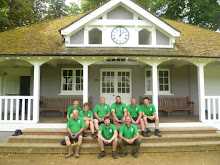 |
| Pollarded Salix alba 'Yelverton' |
 |
| Pollarding Salix alba 'Chermesina' |
The team have got their secateurs, loppers and saws out again having had a five week break from pruning since completing the college climbing plants at the end of January. First are the many
Salix which are
grown for their colourful winter stems, it is the new, young stems that are produced in response to the pruning that give the intense colours. This process of pruning is called
'Pollarding', the removing the annual branches to promote new growth and to leave just a stub, the dormant buds left on the stub will wake up in a few weeks and, by next winter, will create the young stems that will produce yet another colourful display.
The pollarding started on the Broadwalk with the four Golden Willow,
Salix alba 'Yelverton', by removing last year's the stems which have been a rich bronze-red throughout this winter. Next are the the Scarlet Willow by the weir in the Provost's garden,
Salix alba 'Chermesina', which have also provided a stunning display of colourful stems this winter of yellow-orange-red.
The pollarding has been completed but the team will continue to cut over the coming weeks, pruning the
Cornus, also grown for its colourful winter stems, and all the late summer and autumn flowering shrubs in the gardens,
Buddleja davidii,
Sambucus nigra and the
Hydrangea paniculata,
macrophylla and
arborescens.
 |
| Pollarding |
 |
A Pollarded Salix alba 'Chermesina' Stub
|























































